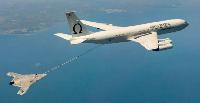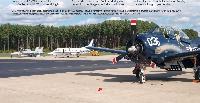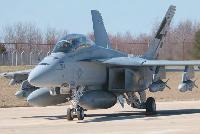Фотографии
-
Регистрационный номер: N707MQ [2] X-47B AV-2 receives fuel from Omega's Boeing 707 tanker N707MQ (c/n 21368) while operating in the Atlantic Test Ranges over the Chesapeake Bay. The test on April 22, 2015 marked the first time an unmanned aircraft refuelled in flight.
Самолёты на фотографии: Boeing Boeing 707/720 - США - 1954Northrop-Grumman X-47 - США - 2003
-
Регистрационный номер: N707MQ [2] X-47B выполняет прием топлива от самолета-заправщика
X-47B AV-2 and Omega's Boeing 707 tanker, N707MQ (c/n 21368) over the Chesapeake Bay near to Naval Air Station Patuxent River.Самолёты на фотографии: Boeing Boeing 707/720 - США - 1954Northrop-Grumman X-47 - США - 2003
-
Самолёты на фотографии: De Havilland Canada DHC-2 Beaver - Канада - 1947
-
De Havilland Canada U-6A Beaver BuNo 150161 is one of two used by the US Naval Test Pilots School.
Самолёты на фотографии: De Havilland Canada DHC-2 Beaver - Канада - 1947
-
An OH-58C Kiowa hover taxies to the main flight line used by the USNTPS.
Самолёты на фотографии: Bell Model 206 Jet Ranger / OH-58 Kiowa - США - 1966
-
An EH-60A Blackhawk assigned to the USNTPS filled with a pitot boom.
Самолёты на фотографии: Sikorsky UH-60 Black Hawk / S-70 - США - 1974
-
Three types of aircraft, each from a different generation, on the USNTPS flight line at Naval Air Station Patuxent River. Nearest to the camera is a privately owned North American T-28B BuNo 140035, and in the background a Saab 340 operated by Calspan Flight Research and an F/A-18F Super Hornet assigned to the school.
Самолёты на фотографии: McDonnell Douglas F/A-18F Super Hornet - США - 1995North American T-28 Trojan - США - 1949SAAB SAAB 340 - Швеция - 1983
-
Самолёты на фотографии: Grumman E-2 Hawkeye - США - 1960
-
Самолёты на фотографии: Grumman E-2 Hawkeye - США - 1960
-
The E-2D's 24-foot diameter rotordome houses Ihe ADS-18 electronically scanned array antenna.
Самолёты на фотографии: Grumman E-2 Hawkeye - США - 1960
-
An E-2D Advanced Hawkeye assigned to Carrier Airborne Early Warning Squadron 125 (VAW-125) Tiger Tails moves into position to be launched off the flight deck of the USS Theodore Roosevelt (CVN 71).
Самолёты на фотографии: Grumman E-2 Hawkeye - США - 1960
-
Самолёты на фотографии: Grumman E-2 Hawkeye - США - 1960
-
E-2D Advanced Hawkeye BuNo 166502 (c/n AA-2) is the second of two System Design and Development aircraft on the VX-20 flight line at Patuxent River.
Самолёты на фотографии: Grumman E-2 Hawkeye - США - 1960
-
Самолёты на фотографии: Grumman E-2 Hawkeye - США - 1960
-
E-2D BuNo 168076 taxis to runway 32 at Naval Air Station Patuxent River. The mission was flown by Air Test and Evaluation Squadron 20.
Самолёты на фотографии: Grumman E-2 Hawkeye - США - 1960
-
AV-1 on the Roosevelt's number one catapult alongside an F/A-18F Super Hornet during manned and unmanned flight operations.
Самолёты на фотографии: McDonnell Douglas F/A-18F Super Hornet - США - 1995Northrop-Grumman X-47 - США - 2003
-
X-47B BuNo 168063/501 on the number one catapult prior to launch from the USS Theodore Roosevelt.
Самолёты на фотографии: Northrop-Grumman X-47 - США - 2003
-
Northrop Grumman's X-47B UCAS-D launches from the USS Theodore Roosevelt (CVN 71) in August 2014 during tests demonstrating its ability to operate safely and seamlessly with manned aircraft.
A shooter signals lor X-47B AV-1 to launch from the flight deck.Самолёты на фотографии: Northrop-Grumman X-47 - США - 2003
-
Unmanned X-47B AV-1 launches from the aircraft carrier USS Theodore Roosevelt.
Самолёты на фотографии: Northrop-Grumman X-47 - США - 2003
-
X-47B BuNo 168063/501 (c/n AV-1) takes the number one wire aboard the USS Theodore Roosevelt.
Самолёты на фотографии: Northrop-Grumman X-47 - США - 2003
-
Самолёты на фотографии: Northrop-Grumman X-47 - США - 2003
-
X-47B BuNo 168064/502 (c/n AV-2) was fitted with an air refuelling probe and an infrared camera system capable of providing precise navigation updates to get the air vehicle into the tanker's moving basket.
Самолёты на фотографии: Northrop-Grumman X-47 - США - 2003
-
Prior to embarking on board the USS Theodore Roosevelt, AV-1 had an automatic wing-fold capability introduced into its software enabling the wings to be automatically folded after landing.
Самолёты на фотографии: Northrop-Grumman X-47 - США - 2003
-
Регистрационный номер: N304ST Saab 340 Airborne Systems Test and Research Support test-bed N304ST (c/n 340A-102) is a highly-modified version of the Swedish-designed turboprop operated by Calspan Flight Research. The ASTARS modifications were completed in early 2010 and feature an integrated F-16 APG-66 fire control radar, MX-15 infrared/electro-optical turret, student cockpit, and instructor's station.
Самолёты на фотографии: SAAB SAAB 340 - Швеция - 1983
-
Самолёты на фотографии: Ryan RQ-4 Global Hawk / MQ-4C Triton - США - 1998
-
The Triton MQ-4C's wingspan measures 130.9ft and the leading edge of the wing is fitted with a de-icing system.
Самолёты на фотографии: Ryan RQ-4 Global Hawk / MQ-4C Triton - США - 1998
-
De Havilland NU-1B Otter BuNo 144670 has been in service with the US Navy longer than any other aircraft. It was delivered to VX-6 on September 28, 1956 and served with 13 others in Antarctica ferrying equipment and personnel to and from the south pole until 1966. It was the last navy Otter to fly in Antarctica and is the only remaining military example of the type in the world. It has been with the USNTPS since it left Antarctica and is primarily used to instruct lateral directional stability characteristics.
Самолёты на фотографии: De Havilland Canada DHC-3 Otter - Канада - 1951
-
The T-38 Talon is the primary fixed-wing aircraft flown by the USNTPS.
Самолёты на фотографии: Northrop T-38 Talon - США - 1959
-
Самолёты на фотографии: Northrop T-38 Talon - США - 1959
-
The first T-6B Texan II advanced primary trainer was delivered to the USNTPS in 2010. The type is used to demonstrate performance, spin and directional stability test techniques.
Самолёты на фотографии: Beechcraft T-6A Texan II - США - 1995
-
Регистрационный номер: N101VS Calspan Flight Research is under contract to the USNTPS to provide use of its Learjet 24D in-flight simulator for student exercises. The aircraft, N101VS (c/n 218) was manufactured in 1969.
Самолёты на фотографии: Learjet Learjet 23 / 24 / 25 - США - 1963
-
Thirty percent of the 42 aircraft assigned to the USNTPS are owned by the US Army including the Beechcraft C-12C Hurons.
Самолёты на фотографии: Beechcraft Model 200/300 Super King Air / C-12 - США - 1972
-
Самолёты на фотографии: McDonnell Douglas F/A-18F Super Hornet - США - 1995
-
Самолёты на фотографии: McDonnell Douglas F/A-18F Super Hornet - США - 1995
-
Самолёты на фотографии: McDonnell Douglas F/A-18F Super Hornet - США - 1995
-
Smoke plumes from the tyres of USNTPS F/A-18F Super Hornet BuNo 165544 seen landing on runway 24 at Pax River.
Самолёты на фотографии: McDonnell Douglas F/A-18F Super Hornet - США - 1995
-
A 1,000lb GBU-31(V)4/B joint Direct Attack Munition fitted with a hard target void sensing fuse enables aircrew to select a fusing option for attacking a hardened target.
Самолёты на фотографии: McDonnell Douglas F/A-18F Super Hornet - США - 1995
-
Sally Dog 120, F/A-18F Super Hornet BuNo 165875/ SD120, carrying an IRST test vehicle.
Самолёты на фотографии: McDonnell Douglas F/A-18F Super Hornet - США - 1995
-
Salty Dog 123, F/A-18F BuNo 166969/SD123, loaded with three GBU-31(V)4/B joint Direct Attack Munitions each fitted with the hard target void sensing fuse.
Самолёты на фотографии: McDonnell Douglas F/A-18F Super Hornet - США - 1995
-
VX-23's NEA-18G Growler BuNo 166641/SD521 loaded with three ALQ-99 tactical jamming pods.
Самолёты на фотографии: Boeing EA-18G Growler - США - 2006
-
The USNTPS is the only navy unit to fly the H-72A Lakota.
Самолёты на фотографии: Eurocopter EC.145 / UH-72 Lacota - International - 1999
Статьи
- -
- News
- Pax: Home of US Navy flight testing
- ??? - Cats and Traps on the Ike /Military/
- A.Spaeth - Greek Triumph /Commercial/
- C.Kjelgaard - CFM's New-generation Engine /Technology/
- D.Isby - Searchers & Hunters /Military/
- D.Unwin - High Performer /Commercial/
- M.Scharenborg, R.Wenink - France's Guardian Angels /Military/
- R.Niccoli - Silvio Angelucci /Military/








































